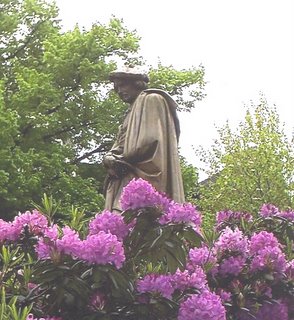Art in Amsterdam: Artists, Museums
Rembrandt. 1606-1669.
Find his history and place in art at ibiblio.org/wm/paint/auth/rembrandt/. At that site, you can click on specific works - go to
The Night Watch - one of his most famous. Here is a fair use thumbnail of
The Night Watch from ://college-de-vevey.vd.ch/auteur/livres/connaissance/tomeIV/night-watch-rembrandt.jpg
The Night Watch.
The 1642 painting is also misunderstood as Night Watch. They are just militia. No reference to time of day. The dark color is not the time of day, or event. Varnish darkened over time and when that was removed in 1942, the name stuck. The group in the portrait, and the real title, is
Company of Frans Banning Cocq and Willem van Ruytenburch, Kloveniersgoven militia, civic guard, caught informally, just before moving out. See ://www.dutchamsterdam.nl/139-rembrandt-night-watch/ Some of the officials did not want to pay because their faces were not full front. See www.historyofholland.com/rembrandt-and-the-nightwatch.html/.
Back to the ibiblio site at the top, click on the sections for his individual portraits - note the light and dark, the light source, the fading and contrasts.
This Rembrandt statue in Rembrandt Square in Amsterdam highlights the light. Walk around it and it appears to move, the folds of the gown, his expression. His house is now a fine museum. See The Rembrandthuis at www.rembrandthuis.nl/cms_pages/index_main.
 Rembrandt Statue, Rembrandt Square, Amsterdam
Rembrandt Statue, Rembrandt Square, Amsterdam
See Rembrandt Square, the old Butter Market, at
aviewoncities.com/amsterdam/rembrandtsquare.
The Rijksmuseum.
This is worth a day in itself. Save your museums for when it rains.
Or, you can download the Rijkswidget and see a different painting from the collection every day. Go to rijksmuseum.nl/widget?lang=en.
Trips trigger the past. I found there a particular painting,
Old Woman at Prayer, by Nicholaes Maes 1656 - a reproduction that was absolutely huge (the original is little) had been familiar since childhood. That is a little kitten scratching at the lower right corner of the tablecloth. Any painting there: see the website's easy referencing.
Old Woman at Prayer.
Fair use thumbnail of Old Woman at Prayer at ://www.wisdomportal.com/Gratitude/Maes-OldWomanPraying.jpgIt is even reproduced in the museum store. To find what you want: start at masterpieces, selecta theme (for this old woman, at her meal, I typed in "woman;" and scrolled across every single object-painting with woman as a main theme. Ingenious locator. Go to rijksmuseum.nl/index.
Going up the walkway, we saw a joint in the lion's mouth and lots of tourists taking pictures. So did we. Amazing how legal things can blend in, regulate behavior as it affects others, but not in privacy; and people just make choices. In the Netherlands, soft drugs like hashish and marijuana are treated differently than hard drugs, and users are not punished: go after the big dealers. Decriminalize.
US approach: Make something illegal as to users. Then see all the negatives of deputizing and enforcers fly about like, pointing fingers, regardless of what they do in their own lives, like so many airborne monkeys. A new Oz.
Van Gogh Museum. Then see the VanGogh Museum across the way. Modern. This site takes you to many cities and sites - go to arounder.com. For the Van Gogh in Amsterdam, go to amsterdam.arounder.com/arounder_specials_van_gogh_museum/java. For VanGogh himself and his art, go back to the Web Museum site, Paris - ibiblio.org/wm/paint/auth/gogh/. We understand that many tours do not go to the Van Gogh because it has an admission fee. It is worth it.
A favorite in Amsterdam - The Potato Eaters, unforgettable look at regular people, homely like you and me, eating regular food.
The Potato Eaters.
Fair use thumbnail of the Potato Eaters from ://www.d.umn.edu/cla/faculty/troufs/anthfood/images/Potato_Eaters_Van_Gogh_April_1885.jpg
Click on the thumbnail of the painting at the site, and the large size appears. For VanGogh fake paintings issues, see vggallery.com/misc/fakes/fakes2.
Johannes Vermeer. A huge mural here. Here is the Rijksmuseum gallery of Vermeer works: rijksmuseum.nl/aria/aria_artists/00017083?lang=en. Girl with Pearl Earring. Vermeer's Painting. See about-vermeer-art.com/vermeer/vermeer-oil-paintings/paintings/1.
Here is Vermeer's Milkmaid.
The Milkmaid.
Fair use thumbnail from ://www.navigo.com/wm/paint/auth/vermeer/vermeer.milkmaid.jpg/ You may remember Vermeer from his Girl With a Pearl Earring, later a book.
 Street karaoke, gender yes, Amsterdam, the Netherlands
Street karaoke, gender yes, Amsterdam, the Netherlands
 Heron on houseboat, Amsterdam NL
Heron on houseboat, Amsterdam NL Houseboats, canal, Amsterdam, NL
Houseboats, canal, Amsterdam, NL Boat-it over for ice cream, canal scene, Amsterdam, the Netherlands
Boat-it over for ice cream, canal scene, Amsterdam, the Netherlands
 Life-size chess board, Amsterdam
Life-size chess board, Amsterdam City block-size sandlot soccer, Amsterdam, the Netherlands
City block-size sandlot soccer, Amsterdam, the Netherlands Anne Frank House, Amsterdam
Anne Frank House, Amsterdam Dusni Synagogue, Spanish Synagogue, Prague. The surroundings of child diarists in WWII, here Petr Ginz
Dusni Synagogue, Spanish Synagogue, Prague. The surroundings of child diarists in WWII, here Petr Ginz Alley-house in Amsterdam. Narrowest house in city?
Alley-house in Amsterdam. Narrowest house in city? Rembrandt Statue, Rembrandt Square, Amsterdam
Rembrandt Statue, Rembrandt Square, Amsterdam